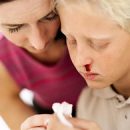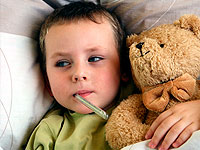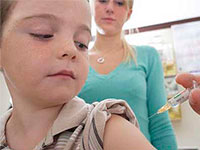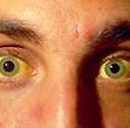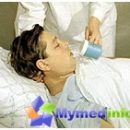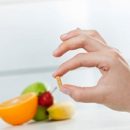Allergic to milk in children - a question that is worried about parents makes thinking and look for an answer to eternal questions: « What to do and how to treat allergies in children?»
Content
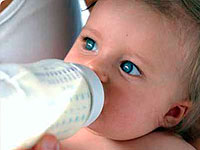 Allergic to milk in children consider one of the current problems of modern pediatrics. Winding in infancy, it can have a serious impact on the formation of an allergological status of a child in the future, including the development of allergic diseases. In the frequency of occurrence, food allergies, including protein, is detected in 6-8% of kids.
Allergic to milk in children consider one of the current problems of modern pediatrics. Winding in infancy, it can have a serious impact on the formation of an allergological status of a child in the future, including the development of allergic diseases. In the frequency of occurrence, food allergies, including protein, is detected in 6-8% of kids.
Cow's milk containing more than 20 antigenic components — One of the frequent causes of food allergies in children up to one year of life. The most dangerous components of milk with maximum allergenic activity — This is casein and beta-lactoglobulin, which are not destroyed by boiling and thermal processing. Children on artificial feeding, as well as in the case of unreasonably early administration of non-adapted milk mixtures and liqueforming. In the future, each newly administered protein, for example, fish, eggs, cereals, especially wheat and rye, poultry meat, with insufficient immune protection of the body can provoke the development of allergic diseases, when the question is invariably asses? Allergies in children develop quite rarely with natural feeding.
Clinical symptoms of food allergies are very diverse, because various fabrics and kids organs may be involved in the immunological process. The most typical is atopic dermatitis, which occurs about at the age of 2-3 months by the foci of redness in the cheek area. Against this background, itching bubbles with bright content appear, then they are erosized and multiple crusts are formed, the process can affect all the body, upper and lower limbs. Acute urticaria with the advent of numerous itchy bubbles of various sizes can manifest itself as an allergy in children in protein and develop when progressing the process into angioedema swelling of quinque in the field of ears, eyelids and nasolabial triangle.
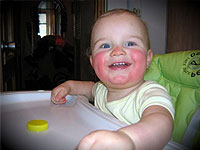 Symptoms of protein hypersensitivity can affect the organs of the digestive system, when the first signs of the disease are found on the skin, passing the intestinal mucosa. In such cases, the kid worries vomiting, nausea, abdominal pain and diarrhea. Allergic intestinal lesion usually flows in the form of an intestinal colic arising from the introduction of artificial blends when the child is worried during food, and cries after feeding.
Symptoms of protein hypersensitivity can affect the organs of the digestive system, when the first signs of the disease are found on the skin, passing the intestinal mucosa. In such cases, the kid worries vomiting, nausea, abdominal pain and diarrhea. Allergic intestinal lesion usually flows in the form of an intestinal colic arising from the introduction of artificial blends when the child is worried during food, and cries after feeding.
The defeat of the respiratory organs can also be a sign of allergies on milk in children, more often manifests itself with bronchial asthma and allergic rhinitis, usually accompanied by skin and intestinal symptoms.
The clinical diagnosis of food allergies is based on the study of allergological history, symptoms of the disease, the beginning of the manifestation of the disease, the relationship of these signs with the introduction of artificial blends or supplies. Significant assistance is provided by the mother's diary, in which the time of food intake, their composition, quantity and reaction of the child are detailed. Analyzing such information, the doctor allergist recommends a special elimination diet except «suspicious» Product. In addition, the detection in the peripheral blood of the specific immunoglobulins of class E with the use of skin samples helps to identify the suspect allergen.
How to treat allergies in children breastfeeding — Panacea from all troubles
The main component of the complex treatment of food allergies is dietherapy, competently built food helps reduce allergic load, support long-term remission and prevent the development of more serious diseases. Therapeutic nutrition of the child of the first year of life is individually developed by a specialist, taking into account the peculiarities of allergies. The main principle of such a diet — This is a strict elimination, t.E. Allergen removal. It is recommended whenever possible to continue breastfeeding, excluding high-caliper food from the mother's diet, including milk and dairy products. To children on artificial feeding, it is advisable to introduce mixtures based on hydrolyzed protein, today they are considered a full-fledged substitute for breast milk.


